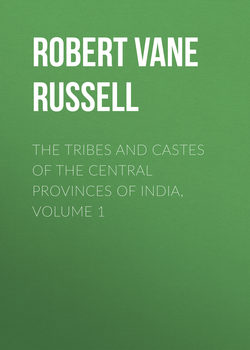Читать книгу The Tribes and Castes of the Central Provinces of India, Volume 1 - Robert Vane Russell - Страница 12
Part I.
Introductory Essay on Caste
Introductory Essay on Caste
9. Occupational theory of caste
ОглавлениеIn the ethnographic description of the people of the Punjab, which forms the Caste chapter of Sir Denzil Ibbetson’s Census Report of 1881, it was pointed out that occupation was the chief basis of the division of castes, and there is no doubt that this is true. Every separate occupation has produced a distinct caste, and the status of the caste depends now mainly or almost entirely on its occupation. The fact that there may be several castes practising such important callings as agriculture or weaving does not invalidate this in any way, and instances of the manner in which such castes have been developed will be given subsequently. If a caste changes its occupation it may, in the course of time, alter its status in a corresponding degree. The important Kāyasth and Gurao castes furnish instances of this. Castes, in fact, tend to rise or fall in social position with the acquisition of land or other forms of wealth or dignity much in the same manner as individuals do nowadays in European countries. Hitherto in India it has not been the individual who has undergone the process; he inherits the social position of the caste in which he is born, and, as a rule, retains it through life without the power of altering it. It is the caste, as a whole, or at least one of its important sections or subcastes, which gradually rises or falls in social position, and the process may extend over generations or even centuries.
Hindu temple of the god Siva.
In the Brief Sketch of the Caste System of the North-Western Provinces and Oudh, Mr. J.C. Nesfield puts forward the view that the whole basis of the caste system is the division of occupations, and that the social gradation of castes corresponds precisely to the different periods of civilisation during which their traditional occupations originated. Thus the lowest castes are those allied to the primitive occupation of hunting, Pāsi, Bhar, Bahelia, because the pursuit of wild animals was the earliest stage in the development of human industry. Next above these come the fishing castes, fishing being considered somewhat superior to hunting, because water is a more sacred element among Hindus than land, and there is less apparent cruelty in the capturing of fish than the slaughtering of animals; these are the Kahārs, Kewats, Dhīmars and others. Above these come the pastoral castes—Ghosi, Gadaria, Gūjar and Ahīr; and above them the agricultural castes, following the order in which these occupations were adopted during the progress of civilisation. At the top of the system stands the Rājpūt or Chhatri, the warrior, whose duty is to protect all the lower castes, and the Brāhman, who is their priest and spiritual guide. Similarly, the artisan castes are divided into two main groups; the lower one consists of those whose occupations preceded the age of metallurgy, as the Chamārs and Mochis or tanners, Koris or weavers, the Telis or oil-pressers, Kalārs or liquor-distillers, Kumhārs or potters, and Lunias or salt-makers. The higher group includes those castes whose occupations were coeval with the age of metallurgy, that is, those who work in stone, wood and metals, and who make clothing and ornaments, as the Barhai or worker in wood, the Lohār or worker in iron, the Kasera and Thathera, brass-workers, and the Sunār or worker in the precious metals, ranking precisely in this order of precedence, the Sunār being the highest. The theory is still further developed among the trading castes, who are arranged in a similar manner, beginning from the Banjāra or forest trader, the Kunjra or greengrocer, and the Bharbhūnja or grain-parcher, up to the classes of Banias and Khatris or shopkeepers and bankers.
It can hardly be supposed that the Hindus either consciously or unconsciously arranged their gradation of society in a scientific order of precedence in the manner described. The main divisions of social precedence are correctly stated by Mr. Nesfield, but it will be suggested in this essay that they arose naturally from the divisions of the principal social organism of India, the village community. Nevertheless Mr. Nesfield’s book will always rank as a most interesting and original contribution to the literature of the subject, and his work did much to stimulate inquiry into the origin of the caste system.
